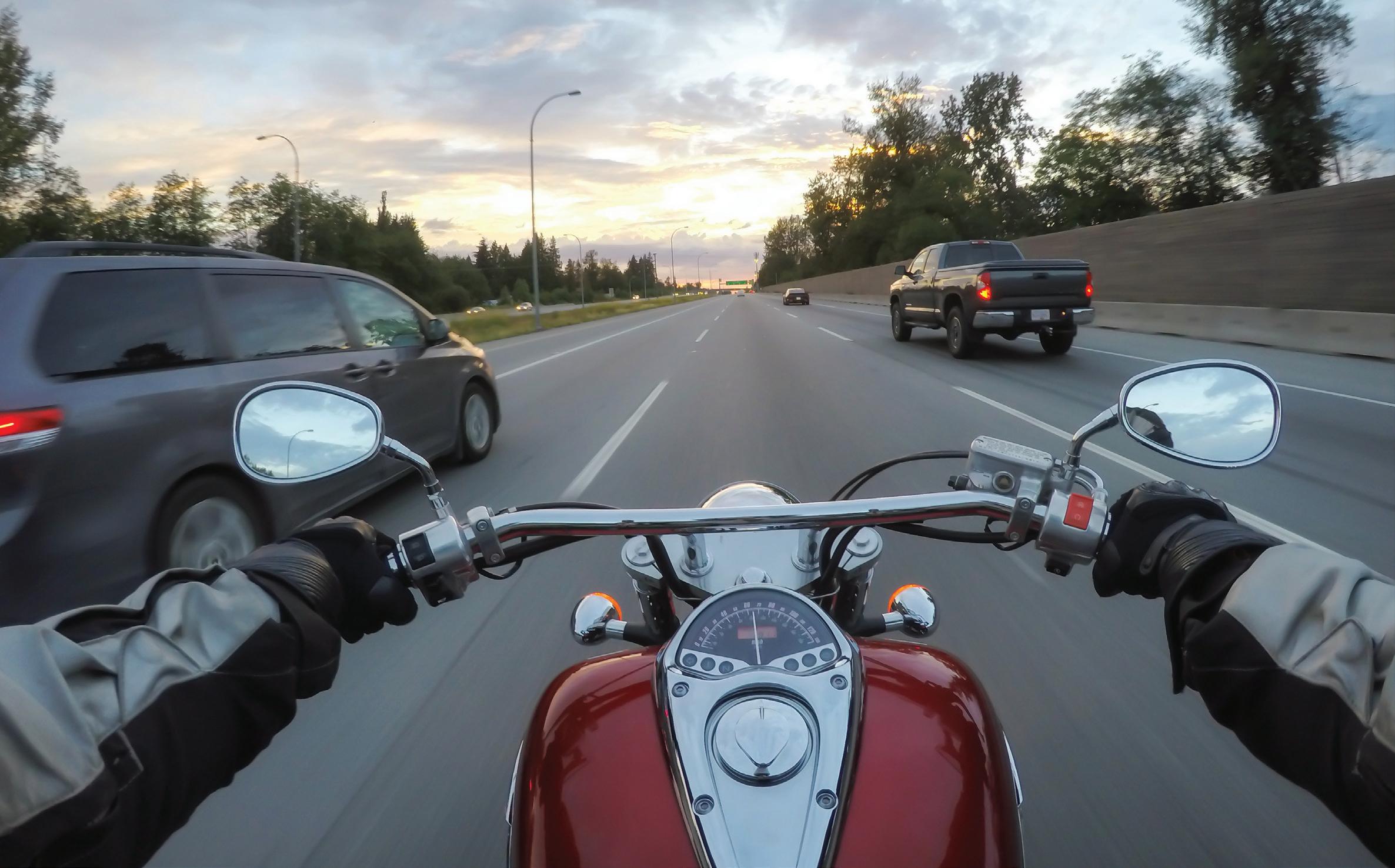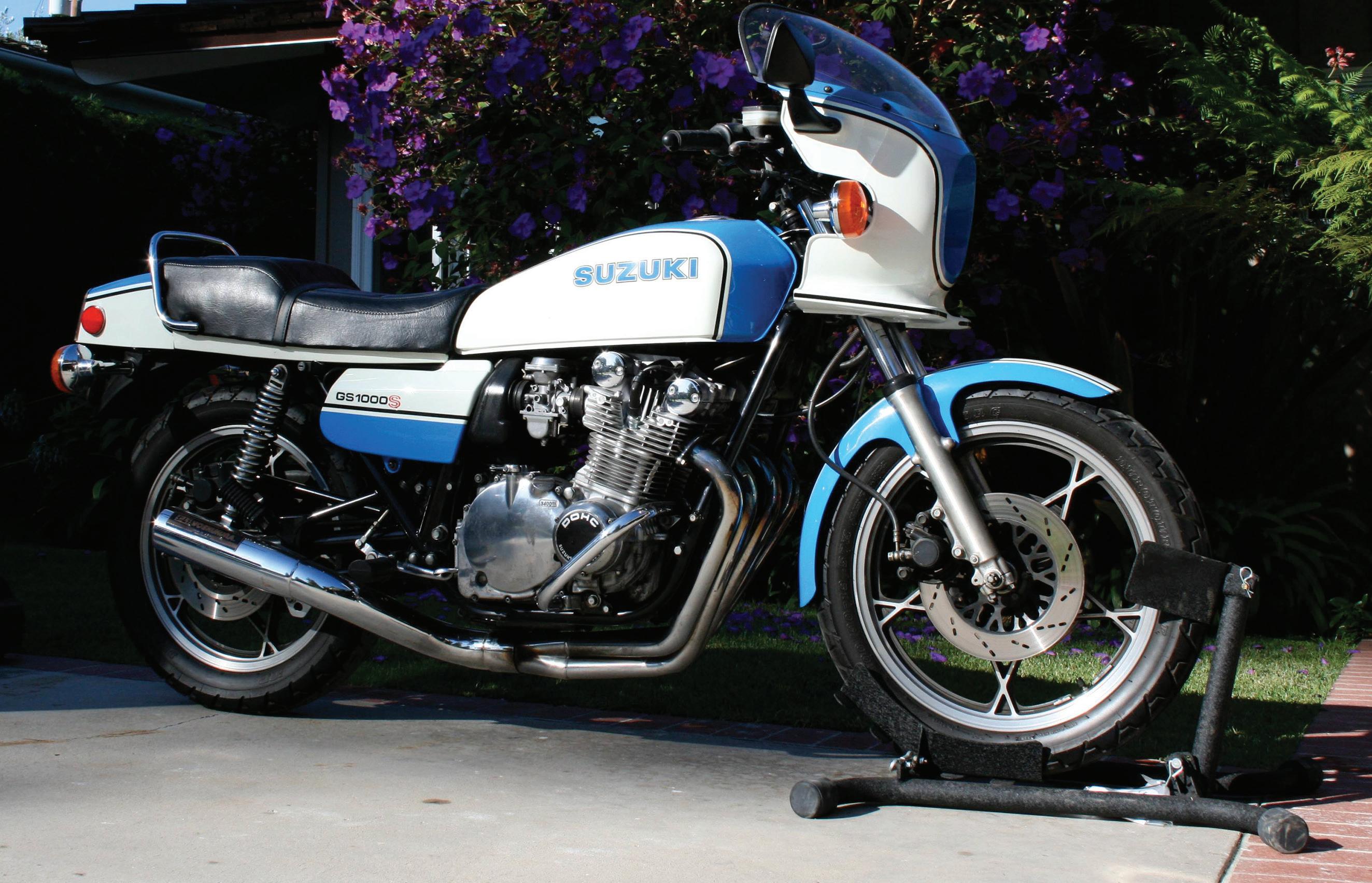
10 minute read
AMA GARAGE
Tips,Tweaks, Fixes and Facts: The two-wheeled ownership experience, explained
STREET SAVVY The Scan

A Springtime review of proper scan technique — a vital part of every rider’s skill repertoire
BY MITCH BOEHM
For anyone who rides their motorcycle in the presence of our four-wheel — or 18-wheel — friends, you know it can be ugly out there.
It’s ugly inherently, as riding on the street on a relatively unprotected vehicle like a motorcycle surrounded by 4,000-pound (or more) cars and trucks has obvious downsides. But these days, with cell phones and touch screens forming such a significant (and unfortunate) part of the experience, it’s extra ugly.
Street riders have a lot to watch for: cars and trucks going every which way (including turning left in front of us, a scenario that remains a top killer of motorcyclists); pedestrians crossing the street where they aren’t supposed to; and all manner of side streets, alleys and sidewalks from where danger (kids, cages, dogs, Bigfoot) can suddenly spring. There’s also moisture, gravel, oil and other slippery concoctions, and don’t forget those pesky potholes, speed bumps, railroad tracks and Armco barriers.
Of course, you’ve also got to monitor your bike’s mirrors and instruments, which means you’ve got stuff ahead, behind and below you. And that’s precisely why proper scan technique can pay huge dividends.
The key to keeping all this motorized craziness at bay? Do not dwell too long on any one zone! Ideally, your eyes and attention will move systematically from what’s ahead to what’s behind you, and then to your instruments.
Obviously, you want to spend the majority of your time analyzing what’s directly ahead, with a smaller portion checking behind you. If one complete scan cycle takes, say, 6 or 8 seconds (how you divvy this up will depend on what seems best for again — with a glance at your instruments every third or fourth front-to-back scan checking for speed, fuel level, brights on/off, and maybe even a forgotten turn-signal flasher.
In traffic, you’ll want to speed up your scan, while on a lonely road it might be 20 (or more) seconds before you look behind you.
your particular road/traffic situation), you might spend 3 to 4 seconds looking ahead, and a couple/three seconds behind before checking what’s ahead
Learn to do this effectively and you will have gone a long way toward making your street miles far safer than ever before.
Staff Rides Boehm: 2008 YAMAHA YZ450F
Facing the realization that a 450 motocrosser is too much bike for me
I’m at a crossroads with the low-hour Yamaha YZ450F I bought a couple years ago. It’s clean and basically unmolested, and it has Enzo Racing-fettled suspension front and rear that meshes really well with my old, fat and arm-pump-susceptible ass. (I’m good for about five laps at a time these days, and then it’s recovery time.)
But it’s a 450, after all, which means any sort of I’m still 22! behavior (which I am prone to, as I’m an expert at forgetting I’ll be 60 this year) can land me in the trauma center for a multi-night stay. (Been there, done that, courtesy of my old Honda CR480 vintage racer.)
So I think that, despite the 450F’s pristine-ness, I’m due not only for an off-road bike that’s lighter and friendlier than a 450 motocrosser, but one that’s more trail-oriented. I enjoy going to the track, but trail riding is a bit more my speed these days. It’s like me riding my e-MTB…I can go longer and enjoy it more than a pedal-only bike and still get a great workout. And I probably won’t get landed on.
I love 2-strokes, their sound and their light weight, so a Beta 200 RR enduro makes a lot of sense. But then I start looking at (and reading about) the topselling and ever-popular KTM 300XC (and Husqvarna TE300), and I start salivating anew. Yes, I am fickle.
It’s winter in Utah as I write this, so skiing is at the top of my activity agenda. But Spring — and riding season — is coming…

Kotoski: 2004 Honda Shadow 1100
American-cruiser aesthetic meets Honda R&D refinement
Ipurchased this 2004 Honda Shadow 1100 Spirit in early 2009 for a nearly year-long, cross-country, border-to-border trip I took that year with my brother. It’s my second bike after I failed miserably at rebuilding a 1984 Suzuki GS700ES in my early twenties. (Details of said rebuild are ugly and cast doubt on my mechanical skills, such as they are, so please don’t ask.) When I purchased the Shadow I wanted something completely reliable — and I got that. I’ve put nearly 25,000 miles on it, on that trip and commuting/ touring around my home state of Minnesota, and the only service item I can report is a dry and sticky ignition switch. At this point I’m patiently waiting for my Minneapolis winter to let up a bit so I can get back on the thing. It might be a while, but fingers and toes are crossed.

Burgess: 2013 Yamaha XT250
First rides aboard what just might be the perfect bike for me
The few days it took for my new-to-me Yamaha XT250 to get to Florida (thanks, Federal Motorcycle Transport!) seemed like forever, and when it arrived I was way beyond excited. But Boehm is a slavedriver — and it was ship week — so I didn’t get a ride ’til that evening.
First impression? Electric start is the best thing ever! If you’ve owned a bike requiring double-digit kicks to light, you know. I geared up, hit the button and took off…brilliant! The XT weighs nearly twice as much as my little XR80, and that took some getting used to, particularly on sandy stretches. But that first ride put a huge grin on my face…instant stress relief!
I’ll admit to dumping it on that first ride. But I picked it up myself and rode on, grin only slightly diminished. I’ve ridden it nearly every day since, and I’m loving life. More soon.

Garage
Baxley’s LA Chock (here) and Sport Chock (below) are must-haves for the enthusiast or garage mechanic.
AM

TESTED Baxley Wheel Chocks
The high-quality, front end stands you can’t live without
BY MITCH BOEHM
Bike stands come in a lot of shapes, sizes and designs, but one of the very best — and most versatile — is the Baxley Sport Chock, which is just one part of the company’s line of wheel chocks.
Built in the U.S. and offering a lifetime warranty, the Sport Chock — and heavierduty LA Chock, which I have used for a dozen years — mix burly construction and clever design into a product we’ve literally come to lean on over the years. Whether you’re using the stand in your garage for bike storage or maintenance, or in the bed of your pickup or trailer when transporting your scoot, the Baxley chock is an amazingly versatile and functional tool.
It’s super easy to use, too. Just position the chock where you want it and roll your motorcycle’s front wheel into the cup-shaped
cradle, which pivots as the front wheel contacts the V-shaped brace and squeezes the tire for added security. Once the tire contacts the front brace the bike is locked into place, and you can literally walk away from it. (There’s also a flip lock, which locks the pivot assembly and adds extra security.)
The chock is a godsend when transporting bikes in my pickup, too. Just position it so the grippy rubber feet are up against the front wall of your pickup’s bed, roll you bike into place and cinch your tie downs. The combo is significantly more secure than tie downs alone, and the chock offers so much stability by itself you could almost drive around without using tie downs at all. This isn’t smart, of course, but it does say a lot about how secure this chock holds your bike. You can also bolt the chock to the floor of a trailer.
“The Sport Chock is the industry standard and is used by OEMs and industry professionals everywhere,” Baxley writes on its website. “You will wonder how you ever lived without it!” Marketing blather is everywhere in this world of ours, but the Baxley folks are definitely not blowing smoke.
The Sport Chock retails for a very reasonable $220 and comes in several colors, while the LA Chock is $299 and comes in wrinkle-black only. There’s also an MX/ Drag/Classic Chock for larger-diameter tires (and a narrower MX/Drag cradle, which converts the Sport Chock into one that’s largertire friendly. Trust us on this one. Baxleycompanies.com

Motor Oil Basics
Understanding the basic differences between synthetic and mineral-based motor oils
BY KEATON MAISANO
We all know motorcycles are key to a happy life, so making sure our two-wheel companions are well-maintained is essential. And part of that crucial maintenance is maximizing the health of our bikes’ engines through proper oilchanging practices.
While timely oil changes, fresh filtering and proper oil levels are by far the most important factors in all of this, there are some key differences in the type of oil you can use to lubricate your engine. In this overview we’ll tackle the two basic types — mineral-based (or petroleum-based) oils, and synthetics.
Motor oils are made up of either petroleum or synthetic base stocks (approximately 75 percent) and additive packages (approximately 25 percent), which include things like antimolecular-shear agents, detergent additives and more.
Traditional oils are mineral-/petroleum-
based and have been pumped out of the ground and refined forever. While they are relatively inexpensive to produce, the process of being refined from crude oil leaves the mineral-based option less pure and thus less chemically stable. This instability leads to easier oxidization and acidification, both of which contribute to the degradation of an oil’s effectiveness over time. The breakdown of mineral-based oil happens more quickly and easily in situations of high heat, high revs and high load.
Option number two is synthetic-based motor
oil, which is synthesized in a lab and therefore offers higher purity and more molecular stability and breakdown resistance — but which costs about three times as much as the petroleum stuff. The upsides to the higher price are that you can a) run synthetics much longer before you need to change oil, and While they are relatively inexpensive to produce, the process of being refined from crude oil leaves the mineral-based option less pure and thus less chemically stable.

b) they do a slightly better job of protecting vital engine parts on ultra-highperformance (and racing) engines.
While the two options provide different pros and cons, there is a hybrid
option known as semi-
synthetic oil, which contains a mixture of petroleum and synthetics. These oils offer some of the benefits of synthetic oil at a lower cost, which is an appealing combination to many consumers.
The bottom line, really, is this: We happily use cheaper, petroleum-based oils in our engines, though we’re careful to change them more frequently — which their low price makes easy. For higherend (or racing) use we often opt for a full synthetic or a semi blend.
Whichever option you decide is best for your bike or budget, be sure to educate yourself on your bike and oil manufacturer’s recommendations.
Happy oiling! AMA








